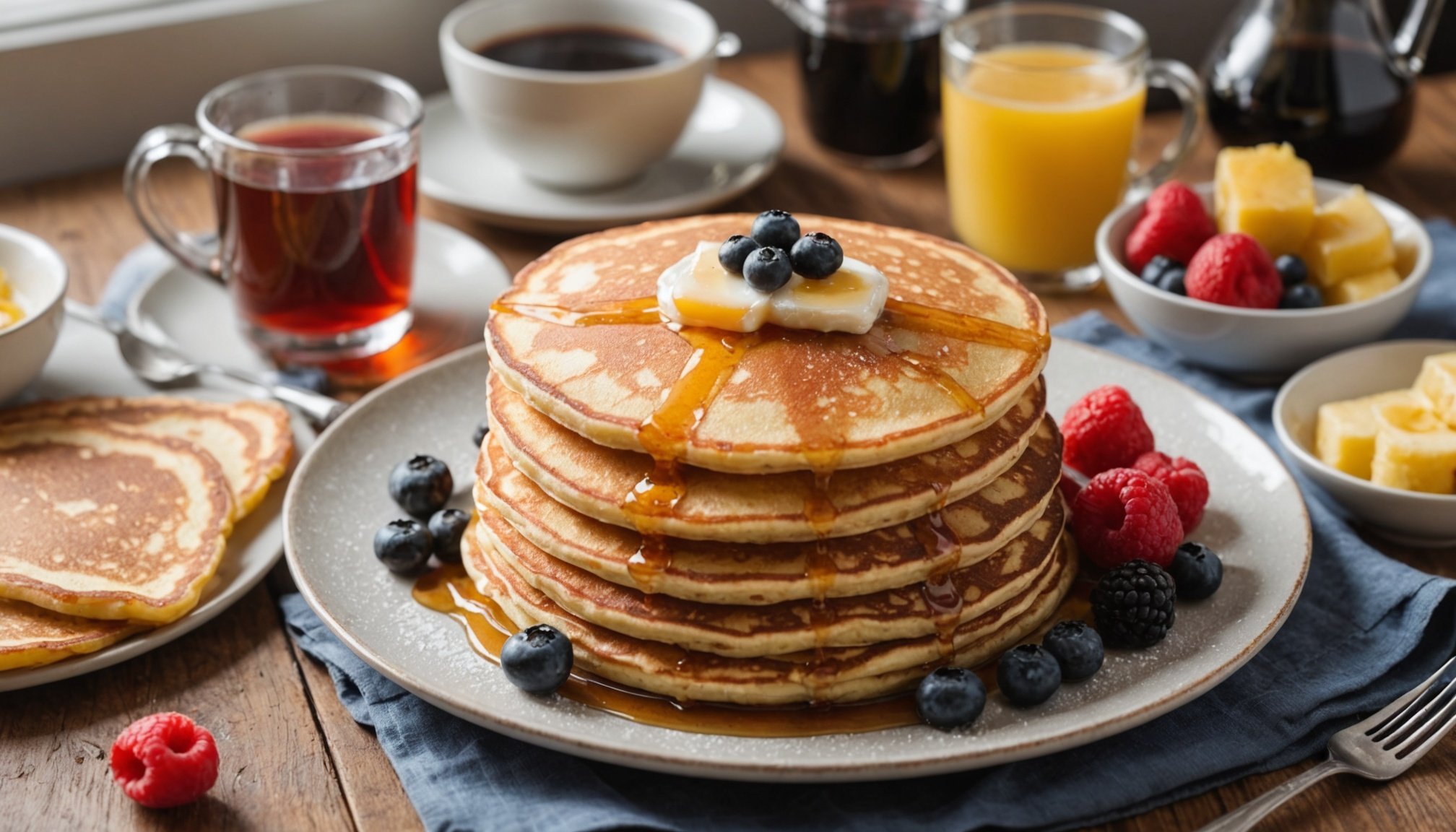Understanding the Basics of English Pancakes
English pancakes hold a unique spot in the culinary world, marked by their distinct characteristics and understated charm. Unlike their American counterparts, they are typically thinner and more delicate. These pancakes are traditionally served flat, often folded or rolled with a delightful filling like lemon juice and sugar.
Key Differences
What sets English pancakes apart from other pancake varieties? While many recipes boast a fluffy texture, English pancakes opt for a light and slightly chewy consistency. Made without the use of baking powder, they forgo the rise associated with fluffier pancakes, offering a more crepe-like texture instead. This simple elegance lets flavors shine through more prominently.
Also read : Mastering decadence: the ultimate guide to crafting irresistibly creamy bread and butter pudding
Ingredient Importance
To achieve the desired texture, the choice of ingredients plays a crucial role. Basic components include flour, eggs, and milk, which together form the backbone of the batter. The proportion of these ingredients defines the pancake’s consistency and ease of cooking. Remember, precision and care in the selection and mixing of ingredients are key to mastering this classic dish.
Understanding these pancake basics helps in appreciating their subtle taste and texture, making them a versatile choice for meals.
Have you seen this : Mastering the art of creamy and tangy lemon posset: your guide to perfection!
Ingredients for Light and Fluffy English Pancakes
Creating the perfect light and fluffy English pancakes begins with selecting the right pancake ingredients. Key components such as flour, eggs, and milk, form the base of the batter. The flour provides structure and texture, while eggs act as a binder creating stability. Milk adds moisture, ensuring the pancake batter is smooth and consistent.
Essential Ingredients
For a truly light and fluffy texture, these staple ingredients can be adjusted. For instance, using a nondairy milk can cater to dietary preferences without sacrificing quality. Additionally, substituting all-purpose flour with alternatives like almond or coconut flour offers a gluten-free option, though it may slightly alter the pancake texture and flavour.
Ingredient Alternatives
To enhance the flavor profile, consider experimenting with ingredient alternatives. Adding a pinch of vanilla extract or a dash of cinnamon can transform the pancakes into a delectable treat. For a healthier twist, replace refined sugar with natural sweeteners such as honey or maple syrup. Understanding the fundamental role each ingredient plays allows for creative customisation without compromising the essential characteristics of English pancakes.
Step-by-Step Recipe for English Pancakes
For many, creating easy pancakes starts with a reliable pancake recipe. Here’s how to craft English pancakes perfect in taste and texture.
Preparation of the Batter
Begin with measuring out your pancake ingredients. Combine flour, eggs, and milk in a bowl, ensuring each ingredient is precise for consistency. Mix gently to avoid lumps, aiming for a smooth blend crucial in achieving a delightful, light texture.
Cooking the Pancakes
Heat a non-stick frying pan over medium heat, and add a thin layer of batter. The cooking technique here is vital; allow the batter to spread naturally. Keeping the temperature even is important to prevent uneven cooking. Once edges lift easily, it’s generally ready to flip.
Tips for Flipping and Serving
Flipping can be tricky—use a spatula for precision. Flip once bubbles form on the pancake surface and cook until golden brown. For presentation, roll or fold the pancakes and serve hot. Consider garnishing with lemon juice and sugar, or explore other topping variations for personal flair.
With these cooking steps, making delectable English pancakes becomes a straightforward endeavor, delighting both palate and presentation.
Techniques for Achieving Fluffiness
Achieving the desired fluffy texture in English pancakes requires precision in handling and cooking techniques. A key aspect is ensuring the batter is mixed correctly. Overmixing can lead to dense pancakes, as it develops gluten, affecting the final texture. Instead, gently combine the ingredients until just blended, leaving a few lumps for optimal fluffiness.
It’s crucial to let the batter rest before cooking. Resting allows the flour to fully absorb the liquid, resulting in a smoother consistency. This step also relaxes the gluten, leading to softer pancakes. Aim for a rest period of at least 15 minutes for best results.
Cooking temperature plays a significant role in achieving fluffiness. Ensure the pan is on medium heat; too hot and the pancakes might burn on the outside while remaining undercooked inside. For timing, watch for bubbles forming on the surface before flipping. This indicates the bottom side is adequately cooked and ready to turn.
Incorporating these cooking techniques and texture tips ensures a delightful pancake experience, delighting both taste and texture aficionados.
Common Mistakes to Avoid
In the quest for perfect fluffy pancakes, several common mistakes can sneak in, disrupting your pancake perfection. A typical pitfall is overmixing the batter, which can lead to dense pancakes by overdeveloping the gluten. Instead, aim to mix gently, stopping when the ingredients are just combined.
Timing is also crucial. Rushing the process without letting the batter rest can result in pancakes lacking the desired texture. A rest period of at least 15 minutes allows the flour to fully hydrate, enhancing the smoothness and fluffiness of the pancake when cooked.
Cooking pitfalls often include improper heat management. Cooking on too high a temperature might quickly brown the outside while leaving the inside undercooked. To combat this, maintain medium heat to allow even cooking throughout, watching for tiny bubbles before flipping—this is a telltale sign the batter is ready to turn.
Troubleshooting these cooking pitfalls ensures more consistent results. If you encounter issues during cooking, reassess your technique—consistency in batter texture, temperature control, and timing are key to avoiding the nuances that contribute to pancake mistakes. Incorporating these preventative measures successfully avoids the most common pitfalls inherent to pancake-making.
Serving Suggestions and Variations
Exploring diverse pancake serving ideas allows you to tailor English pancakes to various occasions, delighting your taste buds with creative culinary possibilities. Whether for breakfast, brunch, or dessert, these pancakes adapt beautifully through thoughtful presentation and ingredients.
Popular Variations
Pancake variations abound, with popular choices including both sweet and savoury options. Sweet variations incorporate fillings such as chocolate spread, jams, or fresh fruits, offering a delightful twist on the classic. Conversely, savoury versions may involve cheese, spinach, or ham, transforming the humble pancake into a sophisticated dish fit for lunch or dinner.
Recommended Toppings
Choosing the right toppings enhances the flavour profile of English pancakes significantly. Traditional choices like lemon juice and granulated sugar remain classics, while innovative alternatives such as whipped cream, berries, or syrup add complexity and richness. Consider savoury sauces, like crème fraîche or hollandaise, for a more refined touch.
Creative Serving Suggestions
Experiment with innovative serving styles to elevate your pancake presentation. Rolled or folded arrangements create visual appeal and ease of serving. Incorporate accompaniments like a refreshing side salad or yogurt for balance. By embracing these diverse serving options and variations, English pancakes become a versatile culinary canvas.
User Testimonials and Reviews
Consistency in fluffy pancakes creation is a frequently noted feat in user feedback. Home cooks commend the straightforward pancake recipe and have found success, particularly when they adhere to key cooking techniques. For instance, many users emphasise the importance of not overmixing the batter, citing experiences of dense pancakes as a common pitfall when this advice is ignored.
Users highlight the role of resting the pancake batter. Allowing the batter to rest is repeatedly mentioned as crucial in reviews, with many noticing a marked improvement in texture. A minimum rest period of 15 minutes emerges as a shared tip, enhancing fluffiness and ease in flipping pancakes during cooking.
Amateur chefs also share innovative tips, such as experimenting with ingredient alternatives. Incorporating almond flour for gluten-free options, or coconut milk for a lactose-free twist appears in several reviews, offering adaptability without compromising on taste or texture.
Pancake reviews often reveal successful cooking stories, and readers celebrate variety in pancake serving ideas. These stories offer inspiration, encouraging others to try diverse variations and toppings, embracing creativity in their culinary endeavours.











